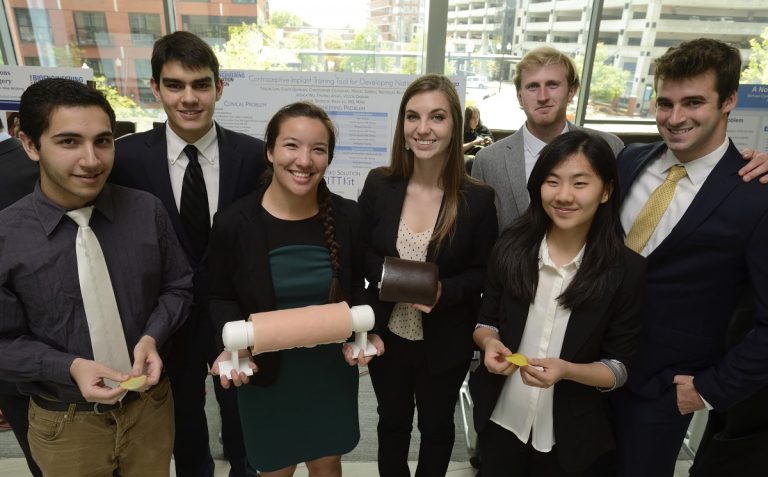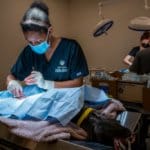
A new, lower-cost prosthesis
When Bill Haris, MS ’16, first walked into his human-robotics interaction class in 2015, he couldn’t have predicted that this was the moment that would ultimately set him on the path to his current position with the US Navy.
The course was designed by Bob Armiger, MS ’06, and Jeff Lesho, MS ’89, PhD ’03, both of Johns Hopkins University’s Applied Physics Laboratory, as a way of connecting master’s students with the duo’s groundbreaking work on the Revolutionizing Prosthetics project by the Defense Advanced Research Projects Agency.
“When they showed us what they were doing with their prosthetic limb program, I approached both instructors and said, ‘How can I get into this?’” recalls Haris, who then embarked upon an independent study project that lasted two semesters.

Haris quickly learned from Armiger and Lesho that in the world of prosthetics, there are two extremes. On one end, there are thought-controlled, highly-dexterous devices that are very expensive to produce. On the other, there are prosthetic limbs printed using 3-D technology. These are a lot cheaper to create but are also less responsive.
“Bill’s project was really about connecting the two dots,” says Armiger, “meaning, how can we take some of the lessons learned from the advanced prosthetics [program] and bring them to the very low-cost prosthetics field to improve the quality?”
After collaborating with Armiger, Lesho, and others at APL, Haris figured out a way to bridge that gap. Using open-source technology, he was able to incorporate advancements like pattern recognition, wireless control, machine learning, and multidigit actuation into upper-extremity prostheses for a fraction of the price.
Haris’s advanced 3-D printed prototypes, for example, cost US$500 or less to produce. Comparable devices not created using a 3-D printer might cost tens of thousands of dollars.
The open-source component is critical, not only in providing more affordable prostheses but also in giving scientists a toolkit — an “instructional guide,” notes Armiger — to continually make improvements.
Haris presented his project at the American Academy of Orthotists and Prosthetists 43rd Academy Annual Meeting and Scientific Symposium in March.
Safety in the Skies
As more aircraft continue to crowd our skies, Ryan Gardner, MSE ’08, PhD ’09, has been focusing on ensuring the effectiveness of the Federal Aviation Administration’s new collision avoidance system.
The new system — Airborne Collision Avoidance System X (ACAS X) — is being developed by several organizations under the FAA to help pilots avoid midair collisions when other safeguards have failed. In some ways, it’s the last line of defense when it comes to safety in the air.
Expected to be operational around 2020, ACAS X uses probabilistic models to accurately calculate potential outcomes. Its goals: improve safety and, at the same time, increase operational suitability by reducing the number of unnecessary alerts that pilots receive.

Gardner, who is a computer scientist in the Asymmetric Operations Sector at Johns Hopkins University’s Applied Physics Laboratory, is working with a team that is employing formal methods to assess the system’s safety in all possible situations. While most of the team’s work so far has centered on piloted airplanes, its findings will apply to new standards for unmanned aircraft as well.
“Our primary focus is safety more than the operational side,” says Gardner. “Our goal is to verify that the new system does what it’s supposed to do.”
The Maryland Academy of Sciences recently presented Gardner with the 2016 Outstanding Young Engineer Award, in part for his work on ACAS X.
Can you automate my tomatoes?
We can all agree that growing our own fruits and vegetables is a great way to save money and maintain a healthy diet. So why isn’t gardening more popular? Time, explains recent graduate Miku White.
Gardening is a time-consuming activity and requires effort to maintain a desirable environment. This is why gardening may not be for everyone, especially for people who are busy or who are often away from home.
White wanted to address this time barrier in a meaningful way, so she dedicated her Systems Engineering capstone project to coming up with a solution that could make gardening possible for more people.

In her final presentation, she proposes the Automated-Greenhouse Climate-Controlled Eco System; a home garden system that incorporates automation technologies and other features designed to assist busy people with planning and maintaining a garden project.
By combining integrated sensors and remote user interactions that aid in climate control and watering, White says that ACES could reduce the manpower needed and help create a desirable environment for produce to grow year-round.
The advantage of using automation technology is not only to save labor, but also to increase process efficiency, quality, accuracy, and precision, concluded White.
Born and raised in Japan, White currently works for the U.S. Navy Naval Air Systems Command as an operational research analyst. She earned her master’s degree in the Systems Engineering program at Johns Hopkins Engineering in 2016.
Follow Johns Hopkins Engineering on Facebook, Twitter, YouTube, Google+, Instagram and LinkedIn







